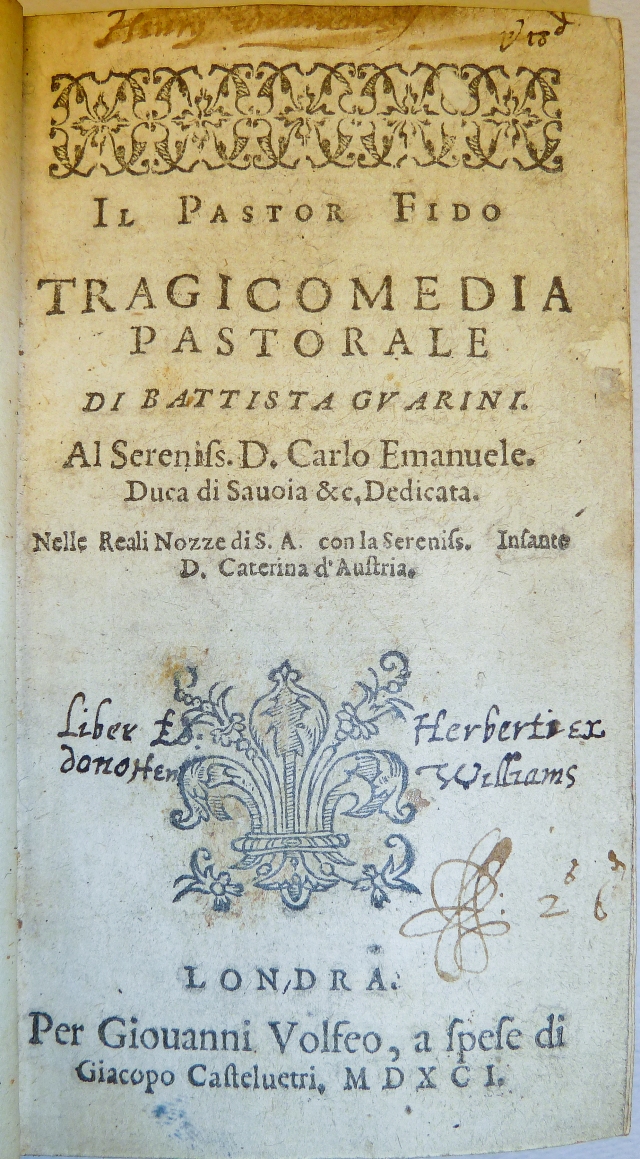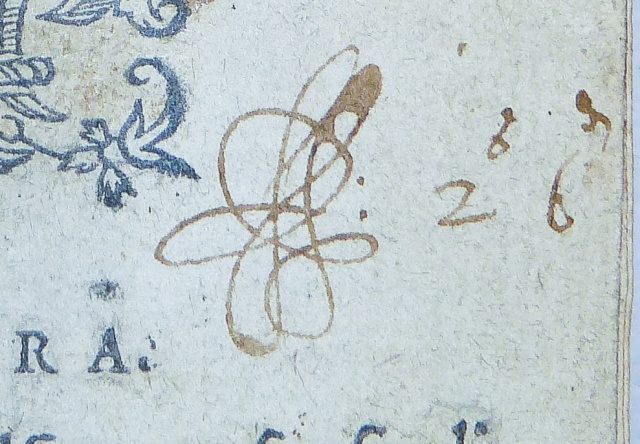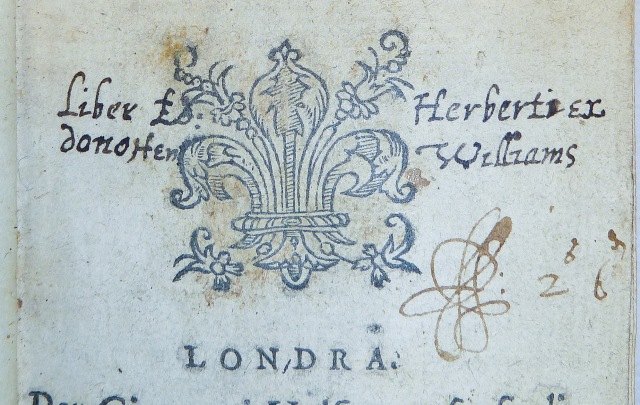Today’s mystery provenance mark comes from a book called “Il Pastor Fido” the “Faithful Shephard”, a tragicomedy from the late 16th century (Penn Libraries: IC55 G9315 590p 1591). The monogram bookplate shown above appears in the upper left corner of the inside front cover the book. This bookplate is so ornately designed that at first the central letters may just seem an extension of the vine pattern wreathing the monogram. Even when the large letters, “M” “L” and “C” become clear, one could easily miss the small “y” inserted near the top between the L and the C. Who’s monogram is this, and why does the little “y” appear?

Penn Libraries call number: IC55 G9315 590p 1591
Two other marks of provenance in the book include the inscription of the name Henry Williams, written at the top of the page and just barely visible beneath the ink someone used to try to blot it out.
Lower down in the title page another inscription marks the book as a gift from Henry Williams to someone named Herbert. Possibly Herbert was the one who crossed out Henry’s name when the ownership of the book was transferred to him?
Who Henry and Herbert were is another mystery, and neither name sheds any light on who the owner using the MLyC monogram may have been, though a flourish underneath the inscription noting the gift suggests the predecessor for the sort of ornate design in the bookplate’s monogram:

Penn Libraries call number: IC55 G9315 590p 1591
The inscriptions by Henry and Herbert look like they come from somewhere around the 17th century. It’s hard to tell whether this flourish and the numbers written next to it [edit: these numbers identified as a price: 2s 6d by Mathew Haley in a comment below] were made by one of them, but it also looks like it comes from a similar period. The flourishes and monograms that ornamented the penmanship of an earlier period were the root of the intricate printed lines that made their way into the design of a bookplate like the monogram above, which is probably from the 19th or 20th century.
If you have any idea whose initials were so elaborately entwined on this bookplate make a comment under the image on the POP Flickr feed, or on this blog post. For all the provenance marks in this book, visit POP here.
For over 13,000 provenance marks and more mysteries waiting to be solved, visit the main page of the POP Flickr Feed.







The numbers next to the flourish are surely a price – 2s 6d (2 shillings and 6 pence)?
LikeLike
Oh, you’re absolutely right. Not sure how I missed that. Thanks!
LikeLike
I don’t know whose is the monogram on the bookplate, but the strange squiggle beside the price is the mark of Edward, Lord Herbert of Cherbury (1583-1648) – to whom, presumably, Williams gave the book as per the inscription?
LikeLike
Excellent! Thanks for the identification. That kind of “strange squiggle” can be hard to pin down. After seeing your response, I was trying to think whether there are good resources on identifying this sort of mark. Do you know if anyone’s written anything on this particular kind of ms mark?
LikeLike
Laura: no, I’m not aware of any one-stop shop for this kind of thing – stuff like this is difficult to classify, let alone identify! There’s the set of solved provenance puzzles on the CERL website which can include things like this, but you’ve obviously got to scroll through what’s there. In so many of these kinds of cases, if you’ve seen it and know what it is, then you know, and if you haven’t it’s hard to know where to start. Maybe the POP Project will develop some kind of registry of hard-to-classify marks?
LikeLike
Interesting – The descendants of Lord Herbert became Earls of Powis and a Herbert married into the family descendants of Clive of India one of whom in time became Earl of Powis .I have the same bookplate on a 1790 edition of Burke’s Reflections on the French Revolution and was told it came from the Clive family . Some of the Powis library was sold off in 1923 . Help!!!
LikeLike
Hi. I think that the initials of this bookplate corresponds to a Spanish name of the late nineteenth century. The structure would be: M [first name] + L [fist surname] + y + C [second surname]. At the end of the nineteenth century there was the fashion of adding a “y” between the two surnames. This then disappeared.
LikeLike
Another of these book labels appears on a 1790 Oxford Book of Common Prayer in the Benton Collection at Boston Public Library. No other ms. clues in the book. But I would guess that the superscript “y” indicates a double Spanish surname, in a form like “Leon y Castilla” or something.
LikeLike
Many thanks – but , Is it likely that an 18th century Spanish , and therefore likely Catholic , reader would possess a Protestant religious book written in English ? Is it not more likely that the “L” and small “y” denote the initial and final letters of “Library” ?
Hal Jackson
LikeLike
It is perfectly possible for a Catholic Spanish to read a Protestant book in English. In addition, there were many exiled Spaniards in the United Kingdom in the eighteenth and nineteenth centuries.
And Il Pastor Fido was translated into Spanish in 1602 by Cristóbal Suárez de Figueroa and in 1694 by Isabel Correa. It was read a lot in Spain.
LikeLike
Perhaps the “Ly” is the usage for “Lady” then and still used by British nobility . “M Ly C”could be used for a nobleman’s second wife .
LikeLike
I now think this might well be the bookplate of Margaret , Lady Clive – when widow of Robert Clive of Plassey She lived at the right time and it explains my comments of June 7 2017 . HJ.
LikeLike